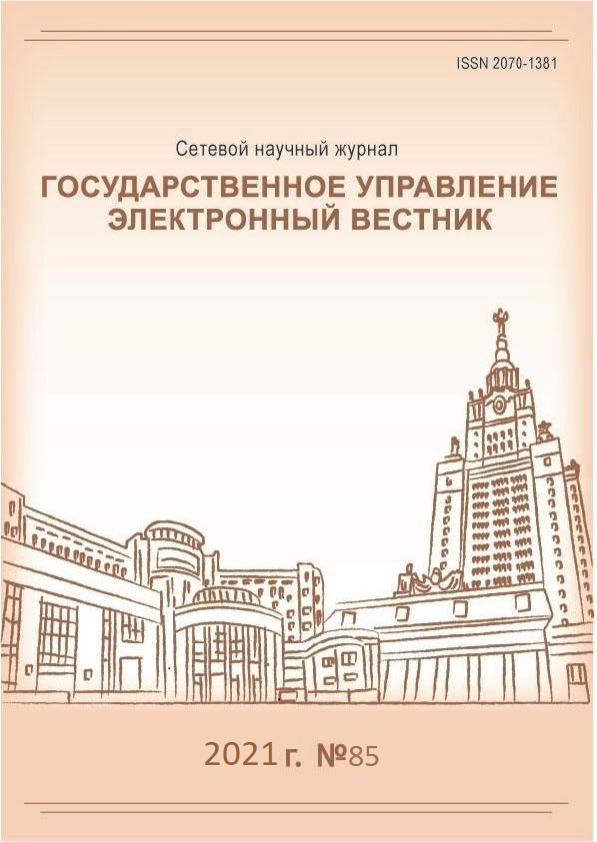National Goals and Institutional Transformations: Model of Strategic Development
Keywords:
National goals, institutional changes, mathematical model, development strategy, institutional matrix, matrix of interactive planningAbstract
The institutional aspects of the national development goals of the Russian Federation, implemented in the system of national projects, objectify the strategy of socio-economic development of the country. The author shows that achieving national goals requires solving the problems of adequate transformation of a number of institutions. The wording of the target indicators allows us to see that the achievement of national goals involves the solution of socioeconomic tasks together with the transformation of a number of economic, political, legal and public institutions and institutions. An urgent scientific task is to reveal the logical and mathematical, including stochastic, relationships between the processes of achieving national goals and reforming the institutional environment. The descriptive stochastic mathematical model of strategic management is used as a research tool. The concepts of an institutional matrix and an interactive planning matrix are introduced to describe the relationship between the process of implementing national goals and the institutional changes. The author shows that the condition for successful implementation of the strategy is the awareness of its developers of the multiplicative-additive relationship of strategic goals and the institutions being created and reformed, taking into account the relationships between them. It is concluded that an unintended deviation in time and efficiency of implementation of each of the national goals may affect the increase in systematic errors in the strategy implementation as a whole. It is shown that the implementation of the strategy in the context of institutional transformations is to provide a differentiated assessment of the results of institutional changes and their interpretation to justify the targets of the strategy next stage. Successful implementation of the strategy requires adequate consideration of the degree of influence on the achievement of each national goal of a set of institutional changes, and does not allow a standard approach to the interpretation of such influence.
References
Аузан А.А. Развитие и «колея» зависимости // Мировая экономика и международные отношения. 2017. Т. 61. № 10. С. 96–105. DOI: 10.20542/0131-2227-2017-61-10-96-105.
Балацкий Е.В., Екимова Н.А. Эффективность институционального развития России: альтернативная оценка // Terra Economicus. 2015. Т. 13. № 4. С. 31–51. DOI: 10.18522/2073-6606-2015-4-31-51.
Клейнер Г.Б. Гуманистический менеджмент, социальный менеджмент, системный менеджмент путь к менеджменту XXI века // Российский журнал менеджмента. 2018. Т. 16. № 2. С. 231–252. DOI: https://doi.org/10.21638/spbu18.2018.204.
Клейнер Г.Б. Проблемы стратегического государственного планирования и управления в современной России // Проблемы стратегического государственного планирования и управления в современной России. Материалы научного семинара. 2011. Вып. 5(43). М.: Научный эксперт. С. 5–36.
Курзенев В., Матвеенко В. Экономический рост. СПб.: Питер, 2018.
Латова Н.В. Акторы запроса на институциональные перемены в современной России (социально-психологический контекст) // Journal of Institutional Studies. 2019. Т. 11. № 3. С. 119–134. DOI: 10.17835/2076-6297.2019.11.3.119-134.
Норт Д.К. Институты, институциональные изменения и функционирование экономики. М.: Фонд экономической книги «Начала», 1997.
Полтерович В.М. Трансплантация экономических институтов // Экономическая наука современной России. 2001. № 3. С. 24–50.
Тамбовцев В.Л. Устойчивое региональное развитие: актуальные направления институционального анализа // Journal of Institutional Studies. 2019. Т. 11. № 3. С. 104– 118. DOI: 10.17835/2076-6297.2019.11.3.104-118.
Шаститко А.Е. Условия и результаты формирования институтов // Вопросы экономики. 1997. № 3. С. 67–81.
Schotter A. The Economic Theory of Social Institutions. Cambridge: Cambridge University Press, 1981. DOI: https://doi.org/10.1017/CBO9780511983863.
Scott W.R. Institutions and Organizations. 2nd Edition. CA: Sage Publication Inc Books, 2001.

